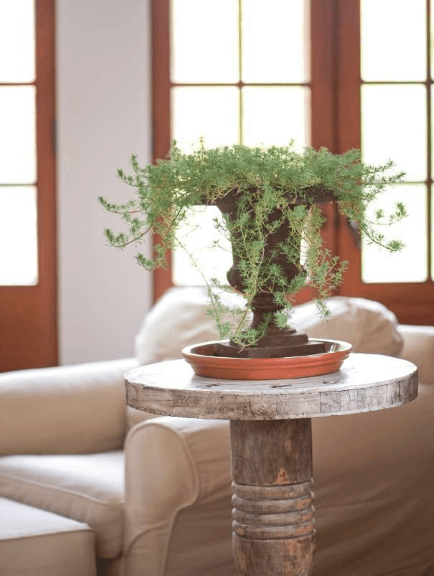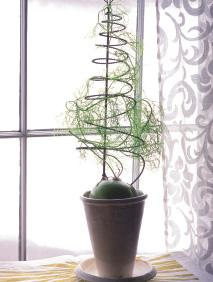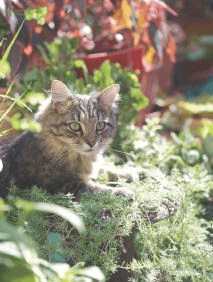[Ebook Việt hóa] The Unexpected Houseplant: 220 Extraordinary Choices for Every Spot in Your Home
[Ebook Việt Hoá] The Unexpected Houseplant: Vines (các loại cây dây leo)
- Nguồn: [Ebook] The Unexpected Houseplant: 220 Extraordinary Choices for Every Spot in Your Home –
- Biên tập: Dũng Cá Xinh (Tháng 02/2022)
- Dịch: Team Codai.net
English
VINES
SEVERAL VINES ERASE the boundaries between indoors and outside, wrapping up the scene and frisking me as well as everyone else who wanders my way. Some spill out the front door in summer. But not all. A few of those vines could not be extracted from their indoor supports without tearing and mauling. So, several firmly entrenched vines remain inside, nourishing my need for green throughout the year. A case in point is the stephanotis. The prospect of moving the stephanotis’s little jungle gym outside is far too daunting to undertake. And without a stephanotis wending around, the house would feel relatively stripped. So it remains indoors.

However, the stephanotis is an exception. Most of the vines are sent out to play, and they take full advantage of the recess, swinging from outdoor trellises or rambling along the ground. Of all the houseplants that go outdoors, the vines make the most growth. They are cut back sternly in autumn when it’s time to come back inside. But in summer, I give them plenty of headroom and let them rip. The result is profuse blossoms, if they happen to be bloomers. If intriguing leaves are their gig, that’s good too.
Generally, I covet sun-lovers in the vine venue. After a brief adjustment period, I situate them where they can bask in the sunbeams. I give their roots the benefit of large containers filled with organic potting-soil mix to nurture their summer growing spree. Even so, they generally need repotting or root-pruning (which I do very gingerly, reducing the vine’s head growth by at least a third in proportion to the quantity of roots I’ve eliminated) when it’s time to come back into the fold in autumn. I fertilize approximately every three weeks, but rarely keep records. The vines themselves turn pale and nudge me to break out the fish emulsion again.
Rising to the challenge of matching a vine with the right support is half the fun. But it can be a difficult if you’re in a new relationship and you don’t know the ropes. Vines always seem to rampantly outperform your greatest expectations. For the most part, you can forget the “first year it sleeps, next year it creeps, finally it leaps” adage when working with tropical vines. Unlike their hardy perennial counterparts, they tend to go straight for leap mode. I’m just as guilty as everyone else of underestimating a vine’s potential and coupling it with a trellis insufficient to shoulder its heft. But finding a support that will fit into a container can be a formidable and fruitless quest. For the most part, container supports are about 3 feet (90cm) tall at the most. To prevent the horror of toppling, be sure to get one with legs that can be inserted several inches into the soil. I also find that a support with several prongs poking into the soil leads to better stability than a single stick. I detest the flimsy plastic supports that come from the nursery with vines such as clematis. They’re ugly and not equal to the task, and your vine will outgrow them in a matter of weeks.
But there’s no reason why a vine needs to grow up. Rather than ascending, another option is to let a trailing plant descend. More often than not, I host trailing plants in tall containers, such as long toms, that let them swoop majestically down. Urns are another solution. In both cases, you’ve got plenty of space for a vine to spill before it hits ground level.
And long, tall containers are my answer to hanging baskets. I’ve never met a hanging basket I could live with. Perhaps because I’m short (I did confess that I’m ridiculously short, didn’t I?), hanging baskets are a pain in the neck. There’s no way I’m going to pull up a stepladder every time a hanging basket needs watering. It’s just not going to happen. So they tend to go thirsty, which takes a rapid toll for a plant with desiccating breezes flowing all around the root system. For all these reasons, and for gardeners of average and above height as well, a tall container is a great solution.
ARISTOLOCHIA GIGANTEA
their hardy perennial counterparts, they tend to go straight for leap mode. I’m just as guilty as everyone else of underestimating a vine’s potential and coupling it with a trellis insufficient to shoulder its heft. But finding a support that will fit into a container can be a formidable and fruitless quest. For the most part, container supports are about 3 feet (90cm) tall at the most. To prevent the horror of toppling, be sure to get one with legs that can be inserted several inches into the soil. I also find that a support with several prongs poking into the soil leads to better stability than a single stick. I detest the flimsy plastic supports that come from the nursery with vines such as clematis. They’re ugly and not equal to the task, and your vine will outgrow them in a matter of weeks.

But there’s no reason why a vine needs to grow up. Rather than ascending, another option is to let a trailing plant descend. More often than not, I host trailing plants in tall containers, such as long toms, that let them swoop majestically down. Urns are another solution. In both cases, you’ve got plenty of space for a vine to spill before it hits ground level.
And long, tall containers are my answer to hanging baskets. I’ve never met a hanging basket I could live with. Perhaps because I’m short (I did confess that I’m ridiculously short, didn’t I?), hanging baskets are a pain in the neck. There’s no way I’m going to pull up a stepladder every time a hanging basket needs watering. It’s just not going to happen. So they tend to go thirsty, which takes a rapid toll for a plant with desiccating breezes flowing all around the root system. For all these reasons, and for gardeners of average and above height as well, a tall container is a great solution.
ARISTOLOCHIA GIGANTEA
Call it the pelican flower or Dutchman’s pipe or another name, this is one of the most bizarre blossoms in creation. Like the native Aristolochia macrophylla that will gladly encase your porch, the tropical Dutchman’s pipe rapidly climbs upward in a tangle of deep-green, heart-shaped leaves. But while you could easily overlook the blossoms on the native version, you cannot possibly miss the otherworldly blooms that A. gigantea produces. They flare at least 3 inches (8cm) wide, with complex magenta and cream patterned markings moving into bright yellow at the center. The center marks the entrance into a curvaceous tube with bristling hairs directed inward to a chamber where the sexual organs await. It’s all geared toward attracting flies. And the smell is part of the fly’s version of “come hither.” It’s not the sort of thing most of us can live with on a daily basis. As soon as the novelty wears off, you’re left with the stench. But if your nose has a high tolerance, give this vine full sun, warm temperatures, and a very hefty support with lots of headroom.
Aristolochia gigantea
- DUTCHMAN’S PIPE, PELICAN FLOWER
| FLOWERS | Huge Dutchman’s pipe–shaped monstrosities with an uncomfortable scent |
| FOLIAGE | Heart-shaped and handsome |
| OTHER ATTRIBUTES |
Totally strange flowers and a great, fast cover-up for a season |
| SIZE | Vigorous climbing vine |
| EXPOSURE | South |
| WATER REQUIREMENTS |
Generous |
| OPTIMUM NIGHTTIME TEMPERATURE |
55–65°F (12–18°C) |
| RATE OF GROWTH | Lightning fast |
| SOIL TYPE | Rich, heavy soil |
| FERTILIZING | Early spring to late autumn |
| PROBLEMS | Whiteflies; take extra care to penetrate the tangle of leaves when spraying a vine for organic pest management |
I let Boweia volubilis climb the curtain rod.
BOWIEA VOLUBILIS
You want a plant with character hanging around, and the climbing onion (Boweia volubilis) certainly qualifies. Although it is related to lilies, the flowers aren’t the major show here. The blossoms are actually just little, tiny (very tiny) sparkling jewels on the roaming vine that wends its way hither and yon. The celery-green vines are cool and seaweed-like, but what they initiate from is even cooler. As the name suggests, the climbing onion sends its lacy foliage from the center of a massive onion-like bulb. Mine is many years old and the bulb has gradually swollen to 5 inches (12cm) over the years. Every summer, it goes dormant to start growing anew late in the season. By the time autumn is in full force, its lacework has formed a network. Give it a serious support. The vines are not heavy, but an older plant will need something to climb on. In the absence of something sufficient and sanctioned, boweia will look elsewhere. To give you a hint, the Victorians used them as green curtains.
Climbing onions prefer full sun and tolerate considerable drying out between waterings, thanks to their water-storage bulbs. If totally forgotten water-wise, they will slip into dormancy off-season, but mine always revives after a brief snit.
Boweia volubilis
- CLIMBING ONION
| FLOWERS | Minute |
| FOLIAGE | Seaweed-like climbing strings |
| OTHER ATTRIBUTES |
Impressive bulb is part of the picture |
| SIZE | Vigorous climbing vine |
| EXPOSURE | South, east, or west |
| WATER REQUIREMENTS |
Meager |
| OPTIMUM NIGHTTIME TEMPERATURE |
50–65°F (10–18°C) |
| RATE OF GROWTH | Athletically energetic |
| SOIL TYPE | Rich, heavy soil |
| FERTILIZING | While in growth in late summer, autumn, and winter |
| PROBLEMS | Keep all members of the Liliaceae family away from pets who are prone to ingest, especially cats. |

LOTUS MACULATUS
In a windowsill, I can produce only a nod to the claw-like, yellow and red “parrot beak” blossoms that Lotus maculatus is capable of producing. I don’t know where I’m going wrong, because my home is definitely sufficiently chilly to provoke flowers on this Canary Island native. But even so, the needle-like, shimmering silver foliage is entertainment enough, I suppose. I find that L. maculatus and its red counterpart, L. berthelotii, wilt easily, then shrivel their leaves and scatter them all over the floor. In summer, when your lotus is outdoors, this doesn’t tend to be such an issue, making it a splendid plant for a mixed window box. Even though it can cause frequent fussing with
the broom, I haven’t banished mine from indoors for the simple reason that the kitten has adopted its soft bed of leaves for slumbering purposes. Because he’s spoiled rotten, and to keep as much foliage on the upper portion of the plant as possible for his green cushion, I clip mine back regularly.
Lotus maculatus and L. berthelotii
- PARROT’S BEAK, PELICAN’S BEAK
| FLOWERS | Colorful, claw-like blossoms in clusters |
| FOLIAGE | Silver, needle-like leaves |
| OTHER ATTRIBUTES |
Great for window boxes or as a “spiller” in a container |
| SIZE | Trailing showering vine |
| EXPOSURE | South, bright east, or west |
| WATER REQUIREMENTS |
Heavy drinker |
| OPTIMUM NIGHTTIME TEMPERATURE |
50–60°F (10–15°C) |
| RATE OF GROWTH | Medium |
| SOIL TYPE | Rich, humusy, well-drained soil |
| FERTILIZING | Early spring to late autumn |
| PROBLEMS | Can litter foliage |
STEPHANOTIS FLORIBUNDA
If I could choose favorites (and I can’t), this might be a finalist. Quite possibly the best vine for growing indoors, stephanotis is almost always either forming buds or in full blossom with waxy umbels of plump, tubular, sparkling white blossoms that linger long and emit a powdery sweet aroma akin to gardenia but not as cloying. On that rare occasion when the Madagascar jasmine is not forming buds, it has oval, deep-green foliage that is impeccably tidy, handsome, and buttoned down—a description we don’t generally associate with vines. Even the ropy vine itself looks good and is easy to keep in check.
Like most other vines, Madagascar jasmines tend to be hungry. I try to keep abreast of container graduations and give them a beefy organic soil mix with compost included when repotting. However, fertilizing is absolutely required and can continue through winter, if needed. How do you know when to serve food? Your stephanotis will tell you. Watch the foliage. If it begins to pale a shade or two from its ideal dark forest-green hue, fetch the fish emulsion. Great for beginners, this vine tends to be trouble free as far as pests are concerned. Although a sunny window will encourage blossoms, the vine can winter in lower light and still survive perfectly well.
Stephanotis floribunda
- STEPHANOTIS
ALSO CALLED: Bridal wreath, Madagascar jasmine, stephanotis, waxflower
| FLOWERS | Clusters of long, white tubes |
| FOLIAGE | Oval, deep-green, thick leaves |
| OTHER ATTRIBUTES |
Intensely fragrant, used by florists for June bridal bouquets, also blooms for winter holidays |
| SIZE | Rope-like vine is best wound around a loose support, or trained in a circle |
| EXPOSURE | South, bright east, or west |
| WATER REQUIREMENTS |
Medium |
| OPTIMUM NIGHTTIME TEMPERATURE |
55–65°F (12–18°C) |
| RATE OF GROWTH | Medium |
| SOIL TYPE | Rich, humusy, well-drained soil |
| FERTILIZING | Early spring to late autumn, may need additional fertilizer in winter |
| PROBLEMS | Mealy bugs and scale |

THUNBERGIA GRANDIFLORA
The beauty of vines is that they have the potential to spread color over a broad area. Take Thunbergia grandiflora, for example. Arrow-shaped, leathery leaves with clusters of several buds grow from sturdy arms that wind around uncomprisingly clockwise. At the end of a long, drawn-out drama that is part of the seduction, those buds finally unfold into sky blue tubular blossoms that flare 2 to 3 inches (5–8cm) and are absolutely ravishing. Summer is the main show. But my vines have budded up enthusiastically during the dull weather of autumn and stoically through winter, as well. Spring is also clad with flower power. Plus, pests never bother the thick leaves of this thunbergia, but a crystal-like “sweat” that does no harm and is part of the plant’s eccentricities can appear on the flower buds. Full sun is imperative; indoors, this means a south-facing window.
At certain times of year, flowers are at a premium indoors, but Thunbergia grandiflora continues its ongoing electric-blue show.
THUNBERGIA GRANDIFLORA
The beauty of vines is that they have the potential to spread color over a broad area. Take Thunbergia grandiflora, for example. Arrow-shaped, leathery leaves with clusters of several buds grow from sturdy arms that wind around uncomprisingly clockwise. At the end of a long, drawn-out drama that is part of the seduction, those buds finally unfold into sky blue tubular blossoms that flare 2 to 3 inches (5–8cm) and are absolutely ravishing. Summer is the main show. But my vines have budded up enthusiastically during the dull weather of autumn and stoically through winter, as well. Spring is also clad with flower power. Plus, pests never bother the thick leaves of this thunbergia, but a crystal-like “sweat” that does no harm and is part of the plant’s eccentricities can appear on the flower buds. Full sun is imperative; indoors, this means a south-facing window.
Thunbergia grandiflora
- BLUE TRUMPET VINE, CLOCKVINE, SKYFLOWER
| FLOWERS | Large, sky blue blossoms throughout the year |
| FOLIAGE | Deep-green, pointed leaves |
| OTHER ATTRIBUTES |
A very reliable winter bloomer as well as summer |
| SIZE | Energetic climbing vine or dangling vine |
| EXPOSURE | South |
| WATER REQUIREMENTS |
Medium |
| OPTIMUM NIGHTTIME TEMPERATURE |
55–65°F (12–18°C) |
| RATE OF GROWTH | Medium |
| SOIL TYPE | Rich, humusy, well-drained soil |
| FERTILIZING | Early spring to late autumn |
| PROBLEMS | I find it to be trouble free but it can be pestered by scale |
Tiếng Việt
Đang cập nhật



